DODGE JOURNEY 2015 1.G Owners Manual
Manufacturer: DODGE, Model Year: 2015, Model line: JOURNEY, Model: DODGE JOURNEY 2015 1.GPages: 648
Page 401 of 648
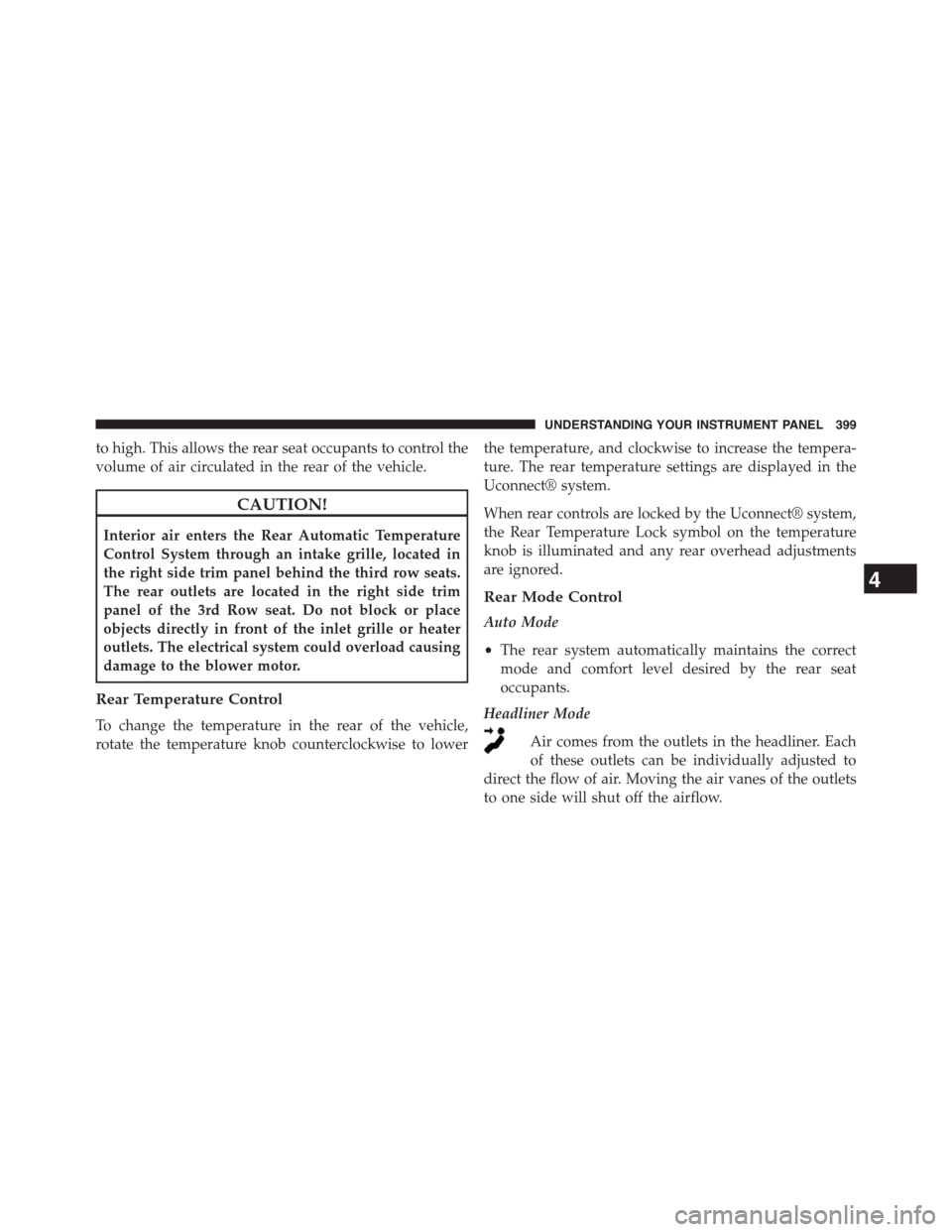
to high. This allows the rear seat occupants to control the
volume of air circulated in the rear of the vehicle.
CAUTION!
Interior air enters the Rear Automatic Temperature
Control System through an intake grille, located in
the right side trim panel behind the third row seats.
The rear outlets are located in the right side trim
panel of the 3rd Row seat. Do not block or place
objects directly in front of the inlet grille or heater
outlets. The electrical system could overload causing
damage to the blower motor.
Rear Temperature Control
To change the temperature in the rear of the vehicle,
rotate the temperature knob counterclockwise to lower
the temperature, and clockwise to increase the tempera-
ture. The rear temperature settings are displayed in the
Uconnect® system.
When rear controls are locked by the Uconnect® system,
the Rear Temperature Lock symbol on the temperature
knob is illuminated and any rear overhead adjustments
are ignored.
Rear Mode Control
Auto Mode
•The rear system automatically maintains the correct
mode and comfort level desired by the rear seat
occupants.
Headliner Mode
Air comes from the outlets in the headliner. Each
of these outlets can be individually adjusted to
direct the flow of air. Moving the air vanes of the outlets
to one side will shut off the airflow.
4
UNDERSTANDING YOUR INSTRUMENT PANEL 399
Page 402 of 648
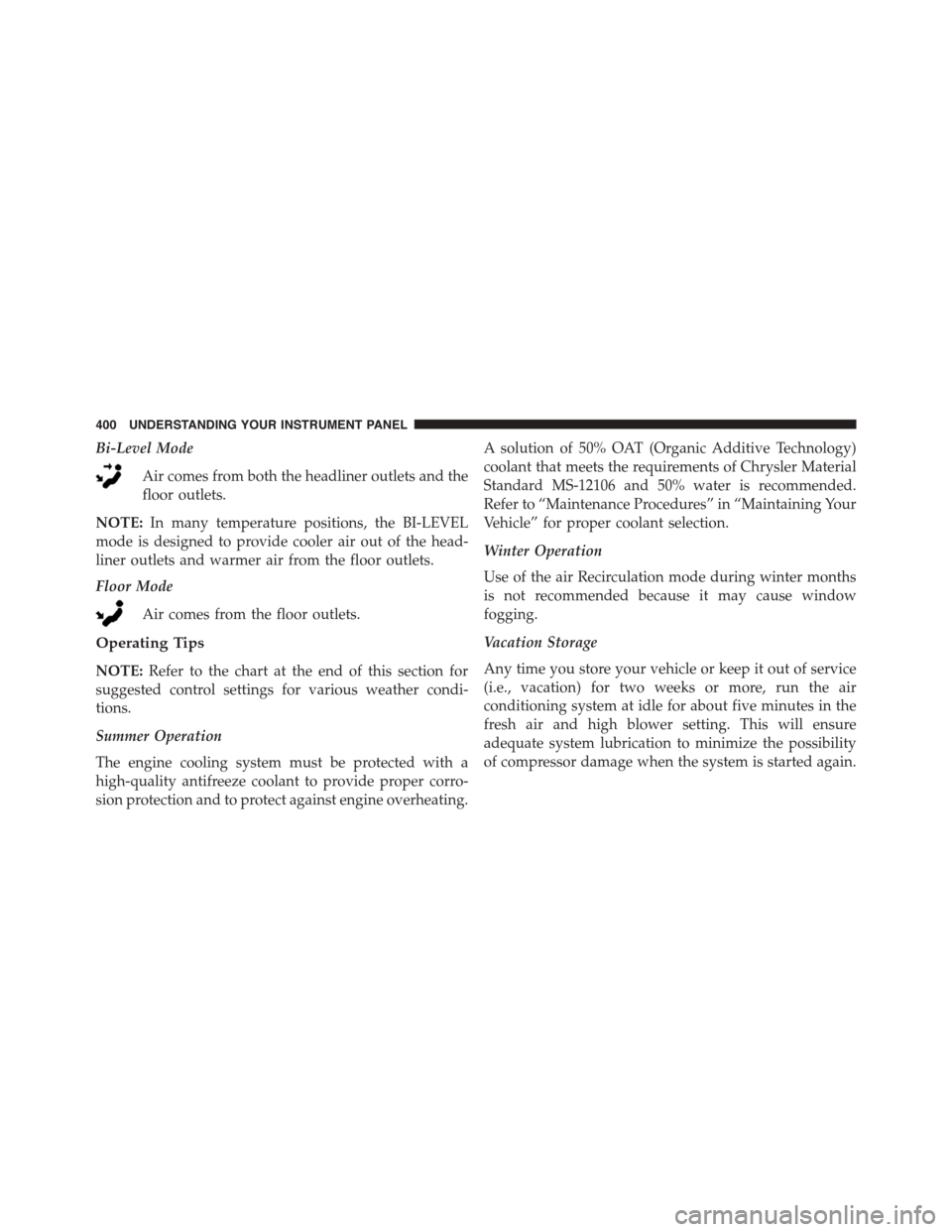
Bi-Level Mode
Air comes from both the headliner outlets and the
floor outlets.
NOTE:In many temperature positions, the BI-LEVEL
mode is designed to provide cooler air out of the head-
liner outlets and warmer air from the floor outlets.
Floor Mode
Air comes from the floor outlets.
Operating Tips
NOTE:Refer to the chart at the end of this section for
suggested control settings for various weather condi-
tions.
Summer Operation
The engine cooling system must be protected with a
high-quality antifreeze coolant to provide proper corro-
sion protection and to protect against engine overheating.
A solution of 50% OAT (Organic Additive Technology)
coolant that meets the requirements of Chrysler Material
Standard MS-12106 and 50% water is recommended.
Refer to “Maintenance Procedures” in “Maintaining Your
Vehicle” for proper coolant selection.
Winter Operation
Use of the air Recirculation mode during winter months
is not recommended because it may cause window
fogging.
Vacation Storage
Any time you store your vehicle or keep it out of service
(i.e., vacation) for two weeks or more, run the air
conditioning system at idle for about five minutes in the
fresh air and high blower setting. This will ensure
adequate system lubrication to minimize the possibility
of compressor damage when the system is started again.
400 UNDERSTANDING YOUR INSTRUMENT PANEL
Page 403 of 648

Window Fogging
Interior fogging on the windshield can be quickly re-
moved by turning the mode selector to Defrost. The
Defrost/Floor mode can be used to maintain a clear
windshield and provide sufficient heating. If side win-
dow fogging becomes a problem, increase the blower
speed. Vehicle windows tend to fog on the inside in mild
but rainy or humid weather.
NOTE:
•Recirculation mode without A/C should not be used
for long periods, as fogging may occur.
•Automatic Temperature Controls (ATC) will automati-
cally adjust the climate control settings to reduce or
eliminate window fogging on the front windshield.
When this occurs, recirculation will be unavailable.
Outside Air Intake
Make sure the air intake, located directly in front of the
windshield, is free of obstructions such as leaves. Leaves
collected in the air intake may reduce airflow, and if they
enter the plenum, they could plug the water drains. In
winter months, make sure the air intake is clear of ice,
slush, and snow.
A/C Air Filter
The climate control system filters outside air containing
dust, pollen and some odors. Strong odors cannot be
totally filtered out. Refer to “Maintenance Procedures” in
“Maintaining Your Vehicle” for filter replacement instruc-
tions.
4
UNDERSTANDING YOUR INSTRUMENT PANEL 401
Page 404 of 648
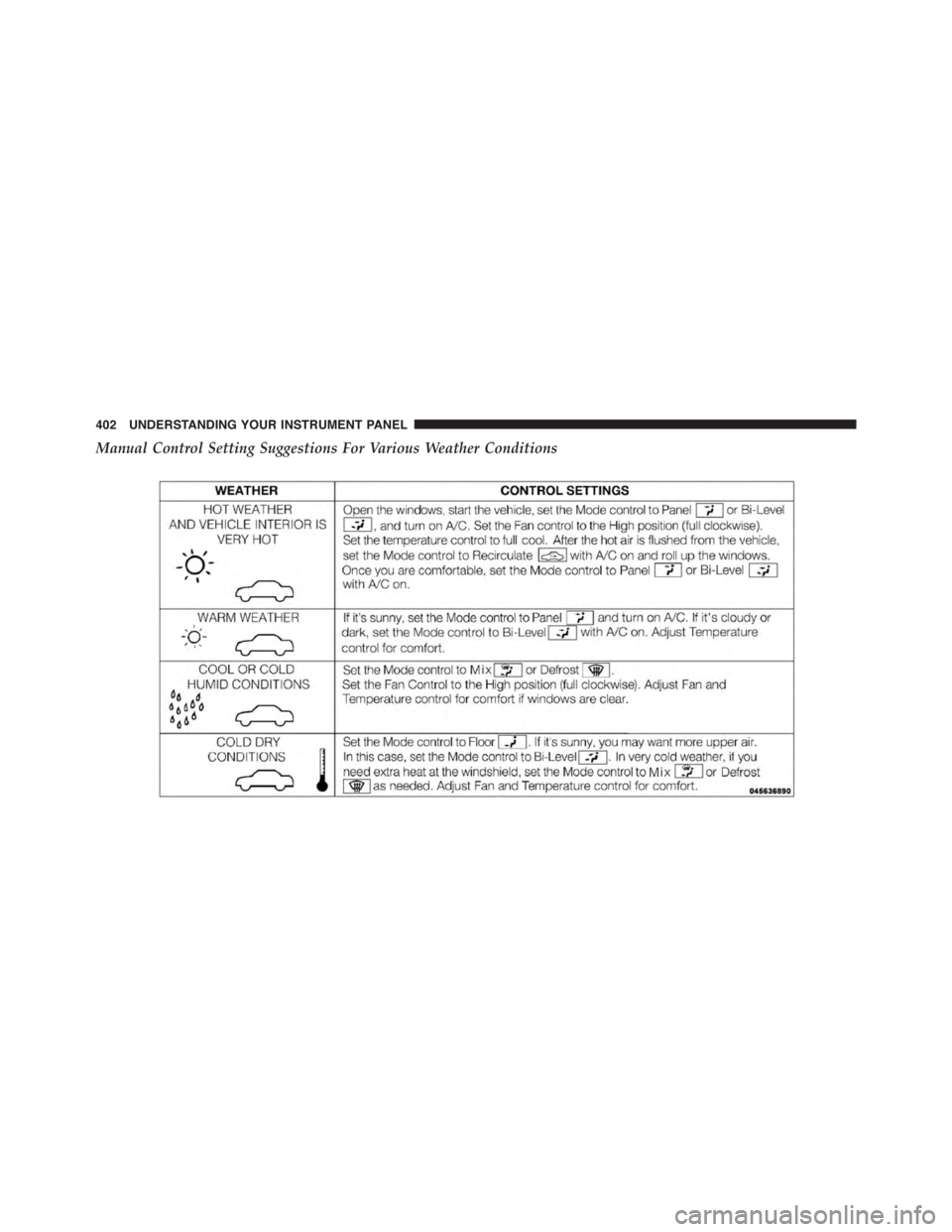
Manual Control Setting Suggestions For Various Weather Conditions
402 UNDERSTANDING YOUR INSTRUMENT PANEL
Page 405 of 648
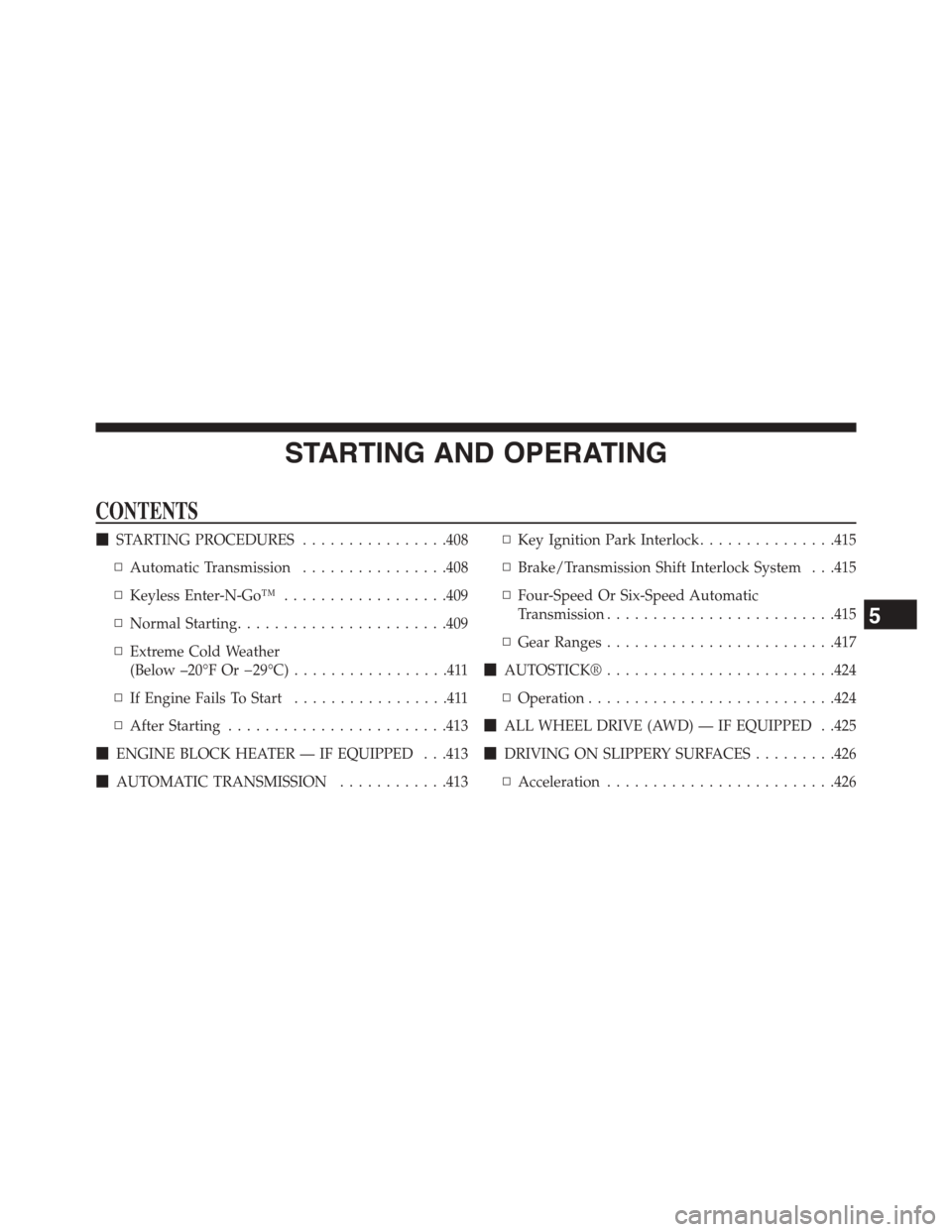
STARTING AND OPERATING
CONTENTS
!STARTING PROCEDURES................408
▫Automatic Transmission................408
▫Keyless Enter-N-Go™..................409
▫Normal Starting.......................409
▫Extreme Cold Weather
(Below –20°F Or−29°C).................411
▫If Engine Fails To Start.................411
▫After Starting........................413
!ENGINE BLOCK HEATER — IF EQUIPPED . . .413
!AUTOMATIC TRANSMISSION............413
▫Key Ignition Park Interlock...............415
▫Brake/Transmission Shift Interlock System . . .415
▫Four-Speed Or Six-Speed Automatic
Transmission.........................415
▫Gear Ranges.........................417
!AUTOSTICK®.........................424
▫Operation...........................424
!ALL WHEEL DRIVE (AWD) — IF EQUIPPED . .425
!DRIVING ON SLIPPERY SURFACES.........426
▫Acceleration.........................426
5
Page 406 of 648
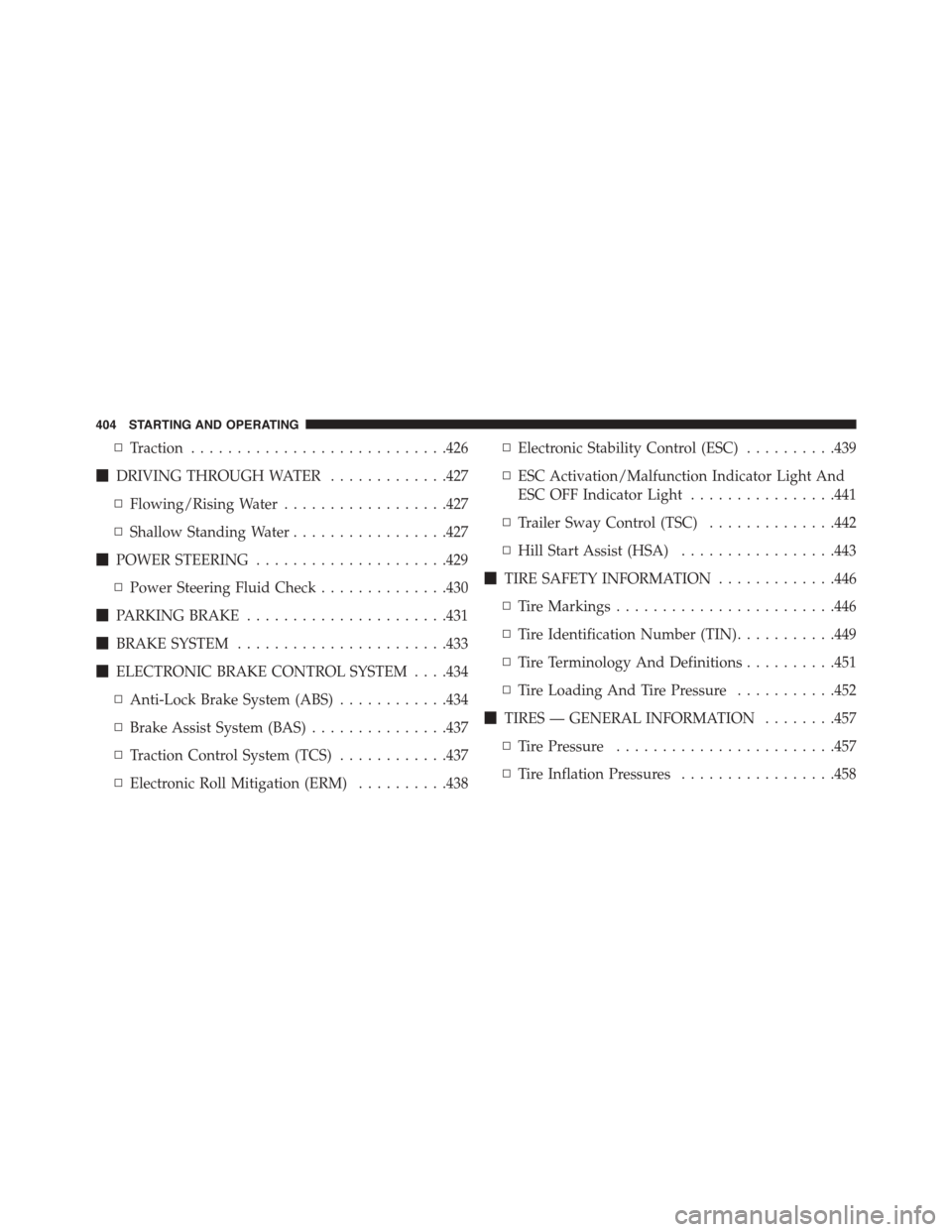
▫Traction............................426
!DRIVING THROUGH WATER.............427
▫Flowing/Rising Water..................427
▫Shallow Standing Water.................427
!POWER STEERING.....................429
▫Power Steering Fluid Check..............430
!PARKING BRAKE......................431
!BRAKE SYSTEM.......................433
!ELECTRONIC BRAKE CONTROL SYSTEM . . . .434
▫Anti-Lock Brake System (ABS)............434
▫Brake Assist System (BAS)...............437
▫Traction Control System (TCS)............437
▫Electronic Roll Mitigation (ERM)..........438
▫Electronic Stability Control (ESC)..........439
▫ESC Activation/Malfunction Indicator Light And
ESC OFF Indicator Light................441
▫Trailer Sway Control (TSC)..............442
▫Hill Start Assist (HSA).................443
!TIRE SAFETY INFORMATION.............446
▫Tire Markings........................446
▫Tire Identification Number (TIN)...........449
▫Tire Terminology And Definitions..........451
▫Tire Loading And Tire Pressure...........452
!TIRES — GENERAL INFORMATION........457
▫Tire Pressure........................457
▫Tire Inflation Pressures.................458
404 STARTING AND OPERATING
Page 407 of 648
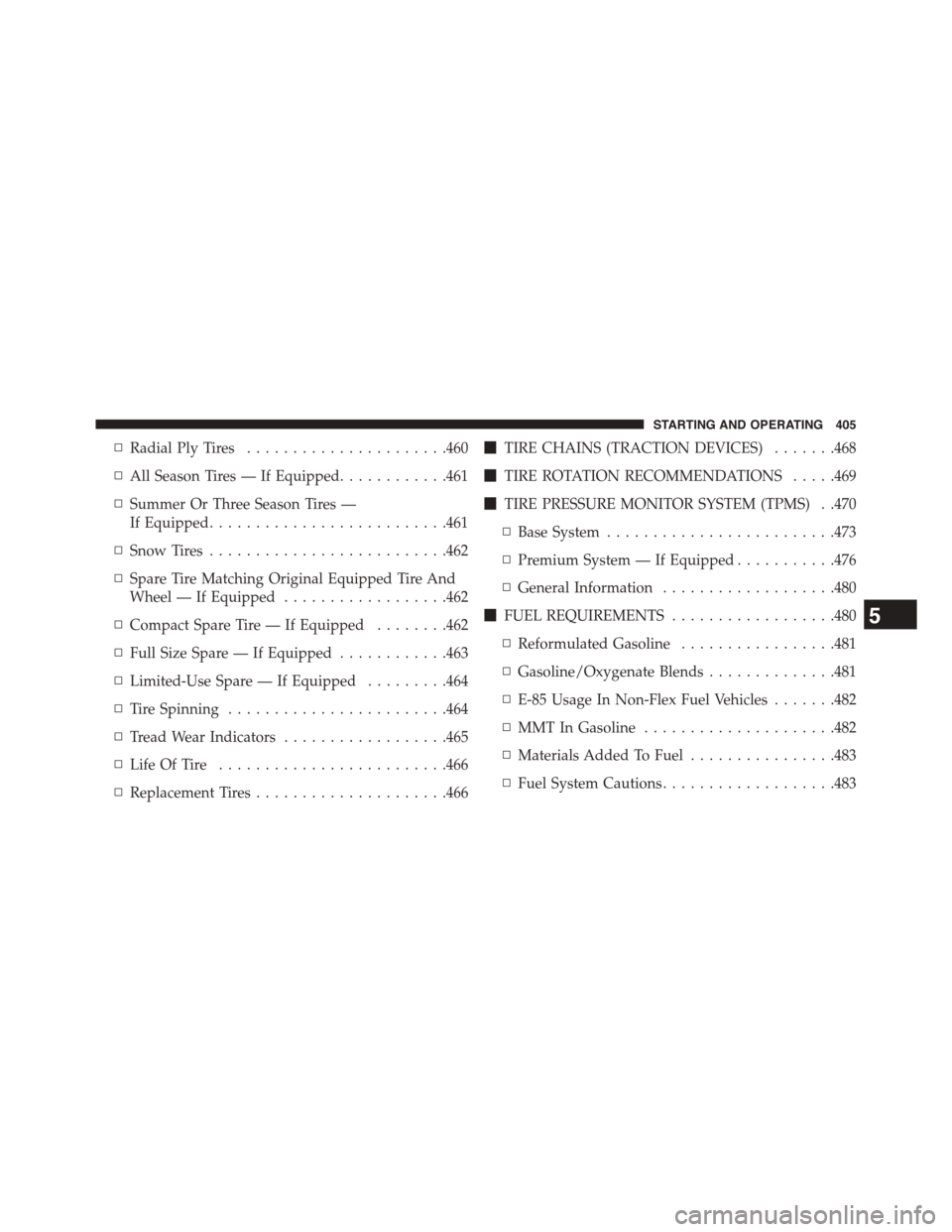
▫Radial Ply Tires......................460
▫All Season Tires — If Equipped............461
▫Summer Or Three Season Tires —
If Equipped..........................461
▫Snow Tires..........................462
▫Spare Tire Matching Original Equipped Tire And
Wheel — If Equipped..................462
▫Compact Spare Tire — If Equipped........462
▫Full Size Spare — If Equipped............463
▫Limited-Use Spare — If Equipped.........464
▫Tire Spinning........................464
▫Tread Wear Indicators..................465
▫Life Of Tire.........................466
▫Replacement Tires.....................466
!TIRE CHAINS (TRACTION DEVICES).......468
!TIRE ROTATION RECOMMENDATIONS.....469
!TIRE PRESSURE MONITOR SYSTEM (TPMS) . .470
▫Base System.........................473
▫Premium System — If Equipped...........476
▫General Information...................480
!FUEL REQUIREMENTS..................480
▫Reformulated Gasoline.................481
▫Gasoline/Oxygenate Blends..............481
▫E-85 Usage In Non-Flex Fuel Vehicles.......482
▫MMT In Gasoline.....................482
▫Materials Added To Fuel................483
▫Fuel System Cautions...................483
5
STARTING AND OPERATING 405
Page 408 of 648
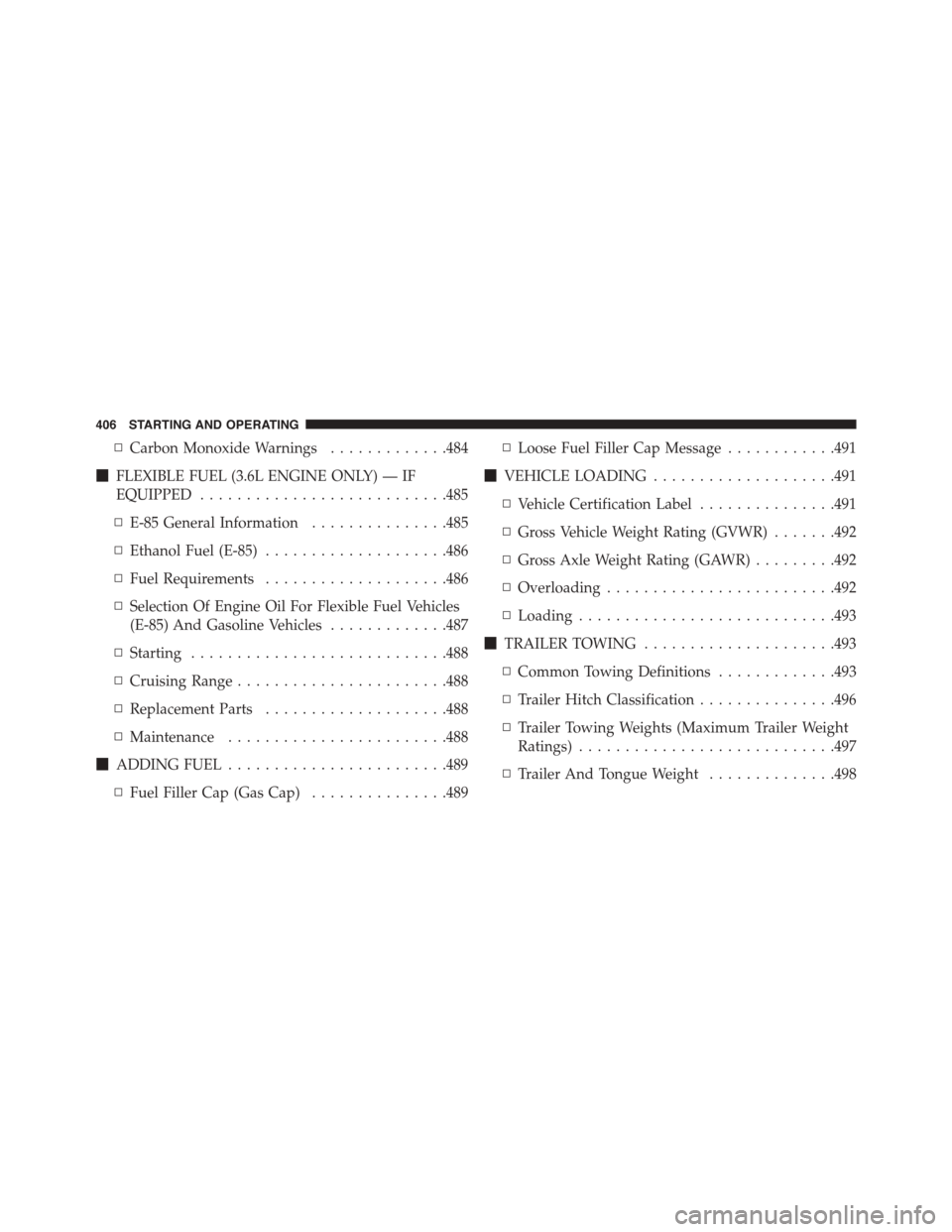
▫Carbon Monoxide Warnings.............484
!FLEXIBLE FUEL (3.6L ENGINE ONLY) — IF
EQUIPPED...........................485
▫E-85 General Information...............485
▫Ethanol Fuel (E-85)....................486
▫Fuel Requirements....................486
▫Selection Of Engine Oil For Flexible Fuel Vehicles
(E-85) And Gasoline Vehicles.............487
▫Starting............................488
▫Cruising Range.......................488
▫Replacement Parts....................488
▫Maintenance........................488
!ADDING FUEL........................489
▫Fuel Filler Cap (Gas Cap)...............489
▫Loose Fuel Filler Cap Message............491
!VEHICLE LOADING....................491
▫Vehicle Certification Label...............491
▫Gross Vehicle Weight Rating (GVWR).......492
▫Gross Axle Weight Rating (GAWR).........492
▫Overloading.........................492
▫Loading............................493
!TRAILER TOWING.....................493
▫Common Towing Definitions.............493
▫Trailer Hitch Classification...............496
▫Trailer Towing Weights (Maximum Trailer Weight
Ratings)............................497
▫Trailer And Tongue Weight..............498
406 STARTING AND OPERATING
Page 409 of 648
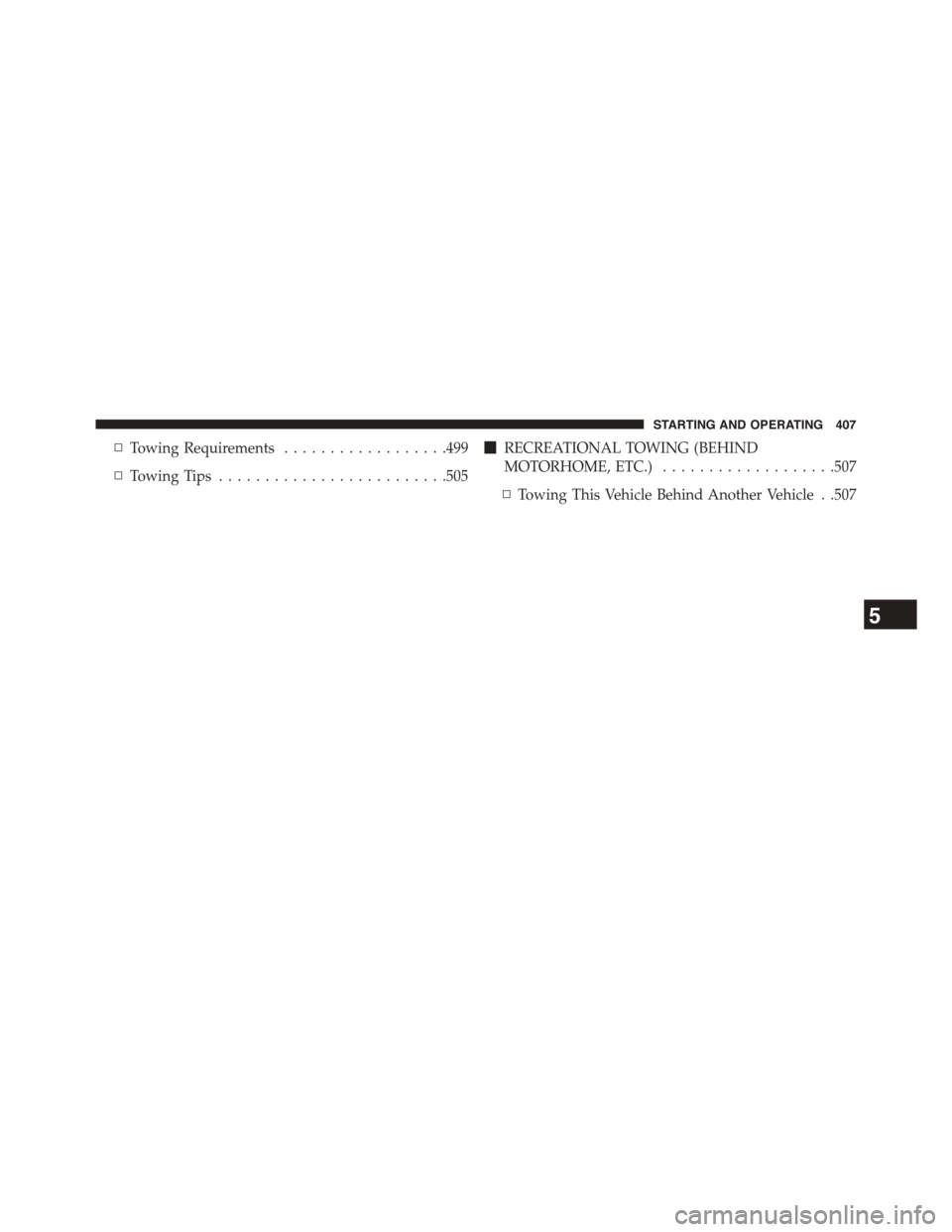
▫Towing Requirements..................499
▫Towing Tips.........................505
!RECREATIONAL TOWING (BEHIND
MOTORHOME, ETC.)...................507
▫Towing This Vehicle Behind Another Vehicle . .507
5
STARTING AND OPERATING 407
Page 410 of 648
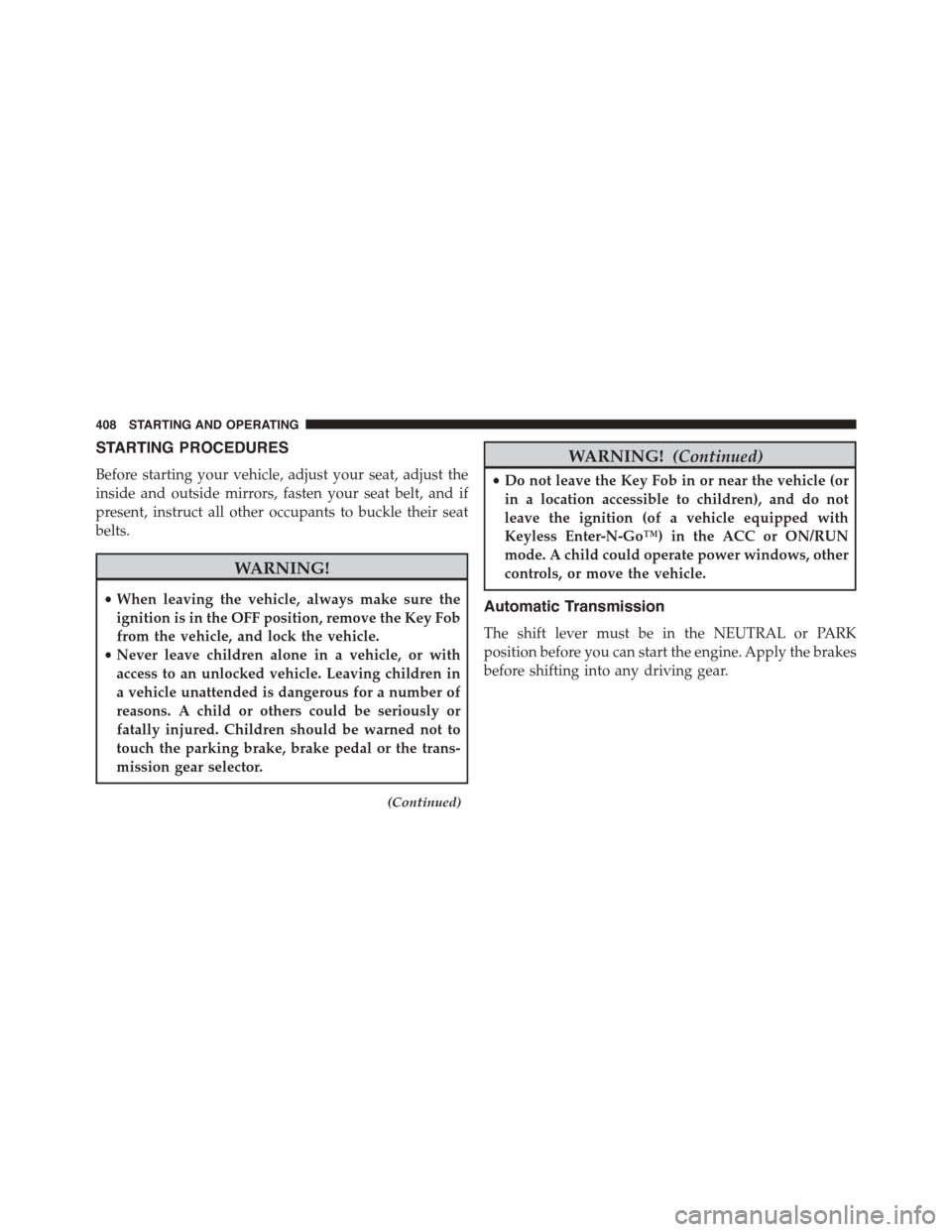
STARTING PROCEDURES
Before starting your vehicle, adjust your seat, adjust the
inside and outside mirrors, fasten your seat belt, and if
present, instruct all other occupants to buckle their seat
belts.
WARNING!
•When leaving the vehicle, always make sure the
ignition is in the OFF position, remove the Key Fob
from the vehicle, and lock the vehicle.
•Never leave children alone in a vehicle, or with
access to an unlocked vehicle. Leaving children in
a vehicle unattended is dangerous for a number of
reasons. A child or others could be seriously or
fatally injured. Children should be warned not to
touch the parking brake, brake pedal or the trans-
mission gear selector.
(Continued)
WARNING!(Continued)
•Do not leave the Key Fob in or near the vehicle (or
in a location accessible to children), and do not
leave the ignition (of a vehicle equipped with
Keyless Enter-N-Go™) in the ACC or ON/RUN
mode. A child could operate power windows, other
controls, or move the vehicle.
Automatic Transmission
The shift lever must be in the NEUTRAL or PARK
position before you can start the engine. Apply the brakes
before shifting into any driving gear.
408 STARTING AND OPERATING